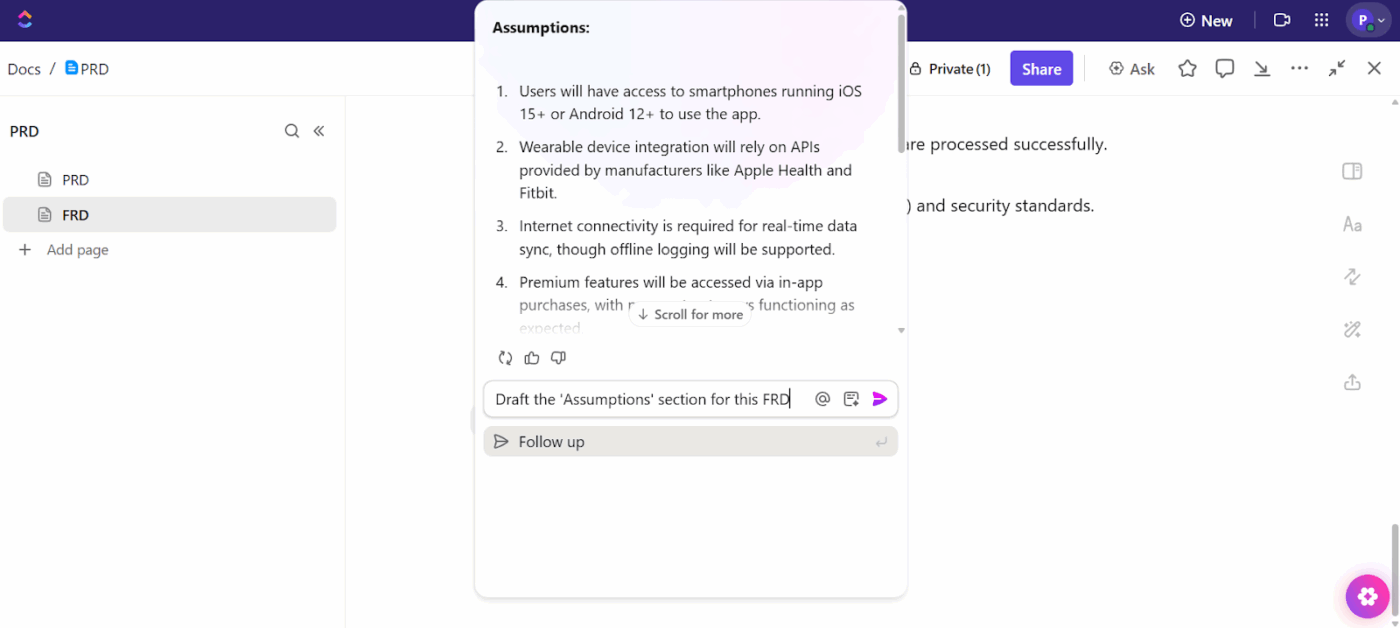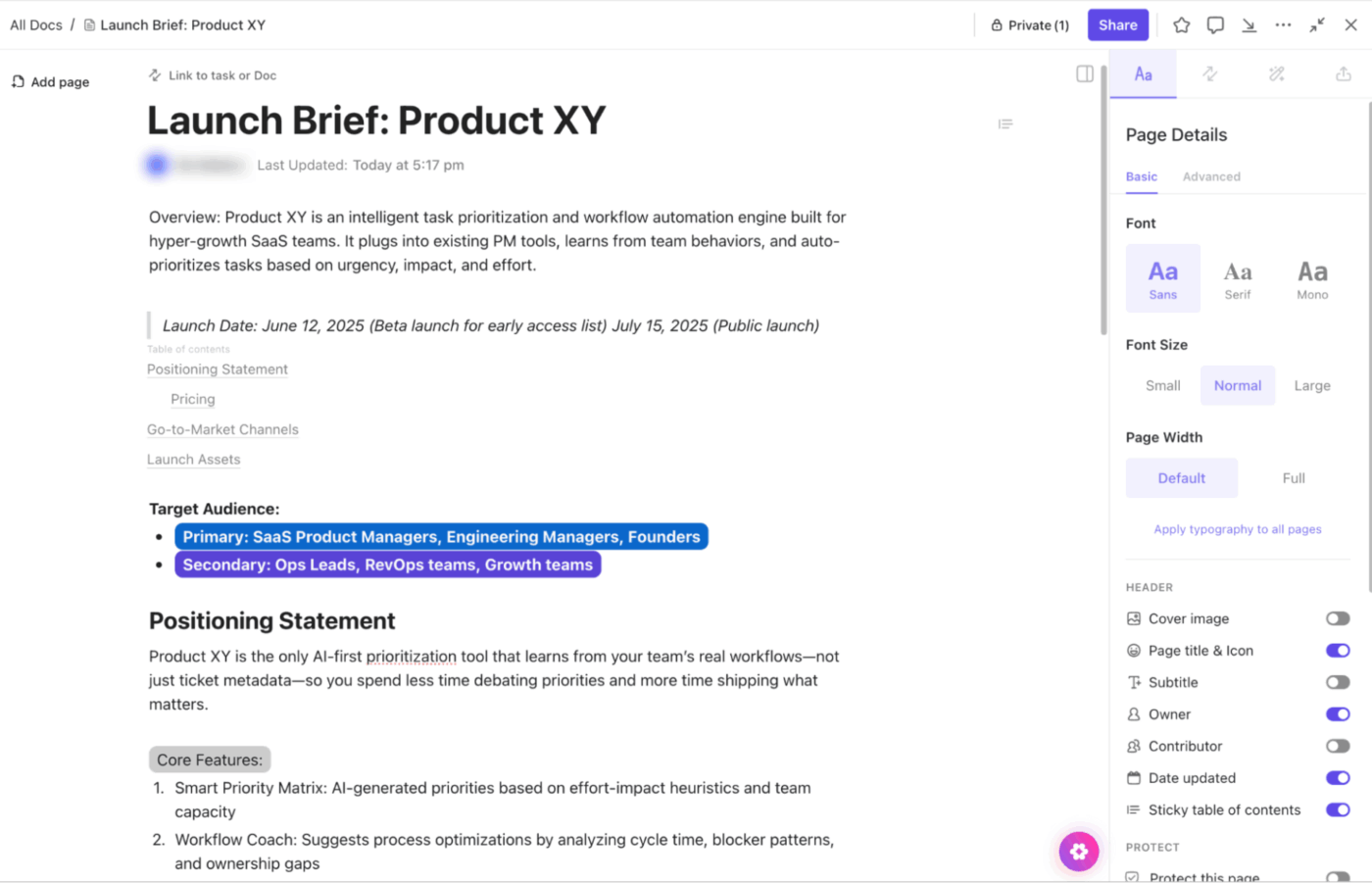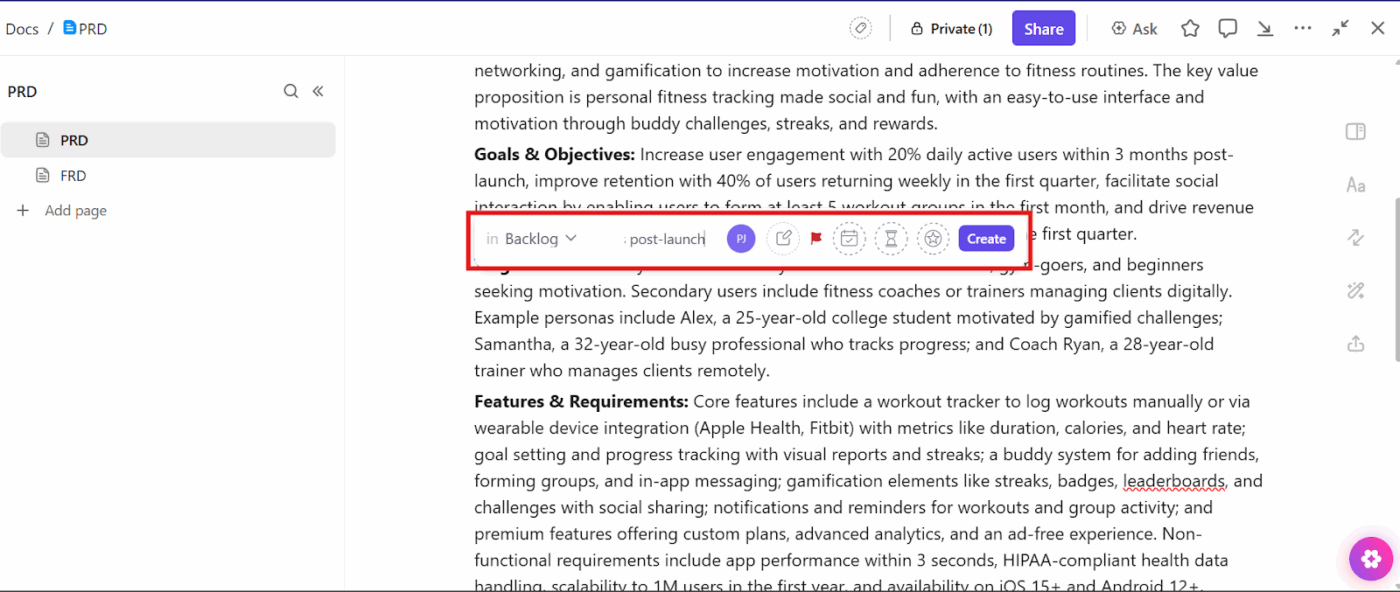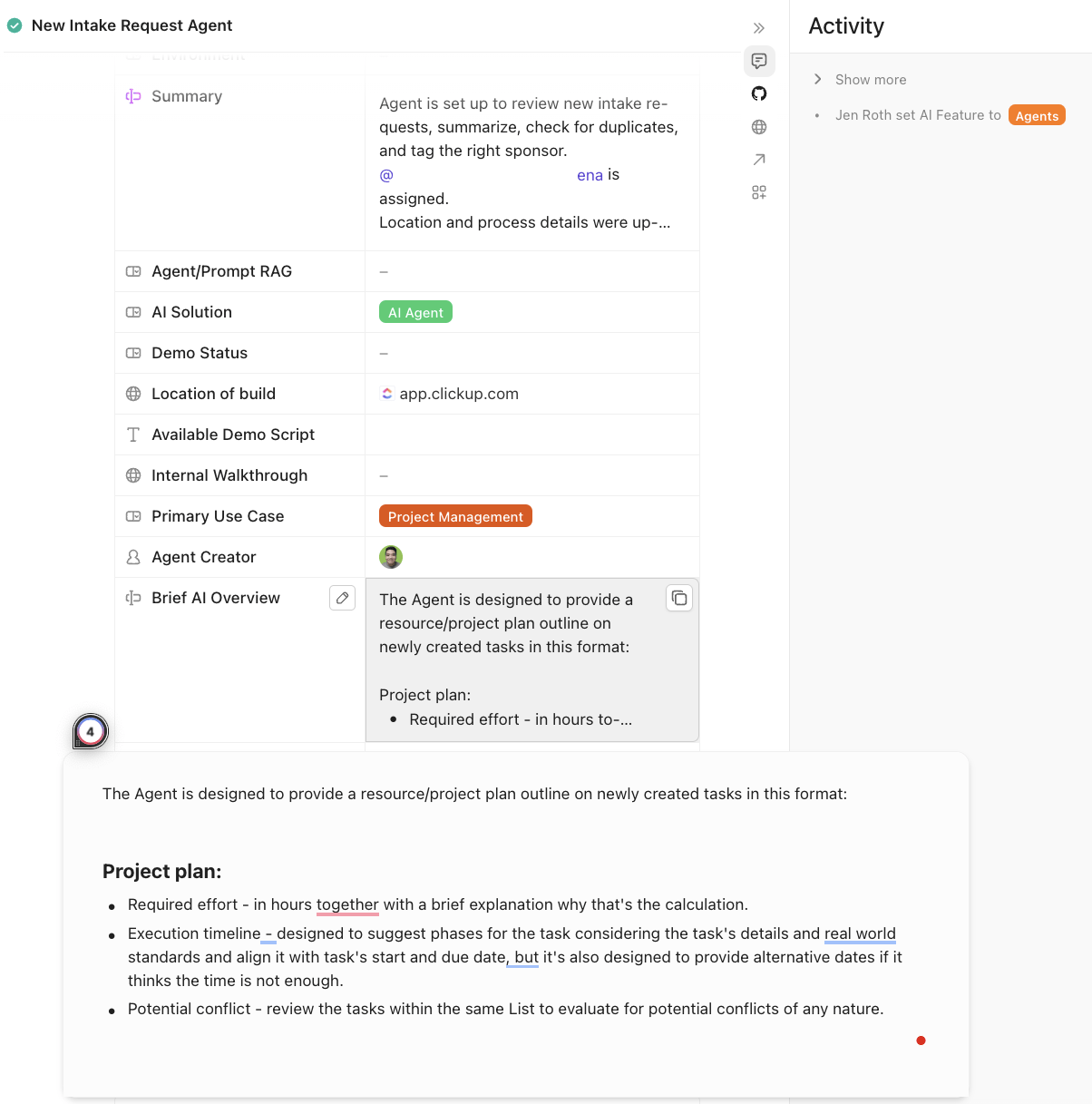PRD vs. FRD: Differences Every Product Manager Should Know

Sorry, there were no results found for “”
Sorry, there were no results found for “”
Sorry, there were no results found for “”

Ever kicked off a product build and found that half the team’s talking about what to build, while the other half’s already knee-deep in how to build it?
In fast-moving teams, this kind of mix-up in product documentation is a recipe for disaster. However, even experienced pros often blur the lines between a Product Requirement Document (PRD) and a Functional Requirement Document (FRD).
In this blog post, we’ll break down PRD vs. FRD once and for all, including what they are, how they differ, and when each one matters most. As a bonus, we’ll also look at how ClickUp helps you write these documents. 🏁
A Product Requirement Document (PRD) is a comprehensive document that outlines all necessary specifications, features, functionalities, and expected behaviors for a product to be developed.
The PRD serves as a single source of truth for cross-functional teams, including development, design, QA, and business stakeholders, throughout the product lifecycle. It’s strategically crafted to connect the dots between business goals, user needs, and high-level features.
The document articulates objectives, like boosting engagement or driving revenue, and maps each feature to real user problems and desired outcomes.
Prioritized based on business impact and relevance, the PRD keeps teams focused on building solutions that serve both the market and the company’s broader strategy.
Here are some example sections commonly found in a PRD:
Other aspects to note include acceptance criteria, non-functional project requirements, performance metrics and KPIs, and any questions or risks involved.
🚀 ClickUp Advantage: The ClickUp Product Requirements Doc Template is a ready-to-use framework to facilitate alignment, collaboration, and clarity throughout the product development life cycle.
Built within ClickUp Docs, the product requirements document template guides teams through all essential sections, including objectives, target users, user stories, features, acceptance criteria, and timelines. It supports real-time editing, task assignments, and commenting directly within the document.
💡 Pro Tip: Embed review checkpoints when writing the PRD. Mark milestones where design, engineering, and product leadership should validate understanding before moving forward, keeping alignment tight across business teams.
A Functional Requirement Document (FRD) is a formal document that clearly details the specific functionalities, features, and behaviors a system or software must have to meet business needs.
It takes the goals and high-level features from the PRD and translates them into detailed system requirements.
The FRD defines what the product or system should do, describing expected operations, user interactions, data handling, and outputs without specifying how these functions are to be implemented.
Additionally, it serves as a contract between business stakeholders and the development team, ensuring a shared understanding of the product’s functional capabilities.
Here are some example sections commonly found in the requirements analysis doc:
Other sections include non-functional requirements, acceptance criteria, assumptions and dependencies, and a glossary.
🚀 ClickUp Advantage: The ClickUp Functional Requirements Template transforms high-level product ideas into detailed, actionable system requirements.
The functional specifications template is tailored for engineering teams, product managers, and QA analysts. It provides all stakeholders with a clear understanding of essentials, including functional specifications, data flows, user interface requirements, and acceptance criteria.
💡 Pro Tip: Include edge-case simulations. For a file upload feature, specify maximum file size, unsupported formats, and behavior when storage limits are reached. Engineers can code robustly, and QA can test precisely.
Here’s a breakdown of PRD vs. FRD to avoid misaligned priorities, confused teams, and delays in deployment:
| Criteria | PRD | FRD |
| Audience | Business stakeholders, product managers, cross-functional teams | System analysts, engineering/technical teams, developers |
| Focus | Business goals, user needs, product value, ‘what’ and ‘why’ | System behavior, ‘how’ requirements translate to technical features |
| Format | User-focused, vision-driven, high-level features, use cases | System-focused, detailed functional specs, data flows, mockups |
| Level of detail | High-level, broad coverage, may include some non-functional requirements | Detailed, actionable specs for engineering, specific to a release |
| Owner | Product manager, sometimes the business analyst | System analyst, engineering lead, sometimes business analyst |
| Life cycle stage | Early ideation, planning, and aligning on goals | Solution design, preparing for build and QA |
| Usage purpose | Aligning business vision, communicating priorities | Translating product goals into engineering specs and solutions |
| Change frequency | Changes less frequently; tied to strategic business decisions | May be updated throughout development as technical solutions evolve |
| Example content | Purpose, goals, user stories, feature list, use cases, and constraints | Functional flows, business processes, wireframes, and data integration |
Knowing when to use a PRD vs. FRD is all about the stage of your project and the level of detail your team needs.
Start with a PRD early in the product life cycle. Use it to define what the product should achieve and why, focusing on business goals, user needs, and high-level features.
It’s ideal for aligning stakeholders, setting priorities, and ensuring everyone understands the purpose and expected outcomes of the product or feature.
Move to an FRD once the PRD is established and the team is ready to translate goals into technical specifications.
This software requirements document should detail exactly how the system should function. It’s especially important for complex engineering projects, regulated environments, or when multiple development teams need a clear blueprint to follow.
Here are some questions to answer to understand if you should combine both documents:
🔍 Did You Know? The concept of FRDs gained prominence within military projects, particularly during the 1980s. The U.S. Department of Defense’s MIL-STD-2167A standard, introduced in 1985, emphasized the need for detailed software requirements specifications, marking a significant shift towards structured documentation in defense software projects.
📖 Also Read: Product Requirements Documents: An Expert Guide
The ClickUp Product Management Software is the everything app for work that combines project management, knowledge management, and chat—all powered by AI that helps you work faster and smarter.
The document management software gives teams everything they need to document, collaborate, and execute efficiently.
With ClickUp Docs, creating structured PRDs and FRDs becomes effortless.

Suppose a product manager is rolling out a new mobile app. They can map out the product overview, target audience, and user stories in a shared Doc.
Want to keep the team on track? Embed interactive checklists for feature requirements, use tables to prioritize tasks, and throw in Table or Board views to visualize timelines and dependencies.
On the FRD side, the same team can dive into detailed workflows, functional specs, and data flows with nested documents.
Use Docs for its rich text formatting, code blocks, multimedia embedding, engineering templates, and real-time commenting.
Write exceptional PRDs with ClickUp:
ClickUp Docs allows you to link PRD sections directly to FRD ClickUp Tasks in your workspace, creating a clear connection between high-level objectives and technical implementation details.

For instance, if the PRD specifies a ‘multi-step checkout flow,’ each step can be linked to corresponding FRD tasks, including system inputs/ outputs and UI behaviors.
Any updates in the PRD automatically propagate to linked tasks, keeping documentation and execution in sync across the team.
📮 ClickUp Insight: 40% of managers define success by meeting or exceeding deliverables, while others point to timelines (23%), team growth (11%), or stakeholder feedback (13%).
But successful project outcomes don’t just happen. They’re made possible by great processes.
With ClickUp, you can build a project that delivers both. Use Dashboards to track progress in real time, and ClickUp Docs + Tasks to keep expectations clear and connected every step of the way.
💫 Real Results: Boardriders delivered assets 4 weeks faster, leveraging ClickUp’s timeline management and collaboration tools.
🌟 Bonus: ClickUp’s AI Agents can automate, streamline, and enhance the product planning and development process. Customize Agents to:

ClickUp Brain acts as an AI-powered teammate, helping teams draft, summarize, and refine content across PRDs and FRDs.
The AI Writer for Work leverages context from all docs, tasks, and conversations, ensuring your documentation is accurate, concise, and actionable. It can even suggest edits, generate content, or highlight gaps in requirements.

Here are some prompts you can use:
🚀 ClickUp Advantage: ClickUp Brain MAX, the desktop AI assistant, is a complete productivity powerhouse that brings every piece of your work together. You don’t have to manage multiple AI apps like ChatGPT, Claude, or Gemini; it centralizes everything into one subscription, one interface, and one source of truth for your team.
Here’s what it offers:
ClickUp Dashboards provide a centralized view of all your PRD and FRD work, turning complex project data into simple, actionable visuals. With customizable cards, teams can monitor tasks, timelines, and progress in real time.

Here’s how you can use different cards in action:
Here’s what Raúl Becerra, Product Manager, Atrato, had to say about using the product backlog management tool:
We realized we were lacking an effective way to track tasks and had no clear view of what the product team was doing, so we started looking for a new platform. Then we found ClickUp. The platform was the perfect combination–not too technical and confusing, and not too basic. It gave us the flexibility to create, move, and organize teams and projects in their own way.
Looking for tips on using AI for technical documentation? Watch this video:
PRDs and FRDs serve different purposes, but they’re two sides of the same coin. A PRD lays out the ‘what’ and ‘why,’ while an FRD defines the ‘how.’
ClickUp streamlines both documents in one converged AI Workspace, a unified digital environment that integrates multiple tools and workflows into a single platform.
Outline your PRDs, translate them into detailed FRDs, assign tasks, track dependencies, and collaborate with your team without jumping between multiple tools. Additionally, with AI-powered assistance from ClickUp Brain, the documentation process becomes even easier.
Sign up to ClickUp for free today! ✅
Not always. For smaller projects or teams using Agile, you might get by with just a PRD, or even a combined document. But if your project is complex, highly regulated, or has multiple teams working in parallel, having both can prevent confusion.
The PRD usually comes from the product manager, with input from designers, developers, and stakeholders. Business analysts or system analysts usually handle the FRD, translating the PRD into detailed technical requirements, workflows, and system behaviors.
Yes, especially for smaller projects or Agile sprints. You can create a single, comprehensive document that covers both what the product does (PRD) and how it functions (FRD). But in larger or more complex projects, it’s often better to keep them separate.
While you can start with Microsoft Word or Google Docs, collaboration and version control can become tricky with bigger teams. ClickUp stands out as one of the best options for creating both PRDs and FRDs. ClickUp Docs lets you build structured, easy-to-navigate documents with embedded tables, checklists, and visuals. Plus, ClickUp Brain helps you write faster, summarize lengthy notes, and ensure nothing gets missed.
© 2025 ClickUp